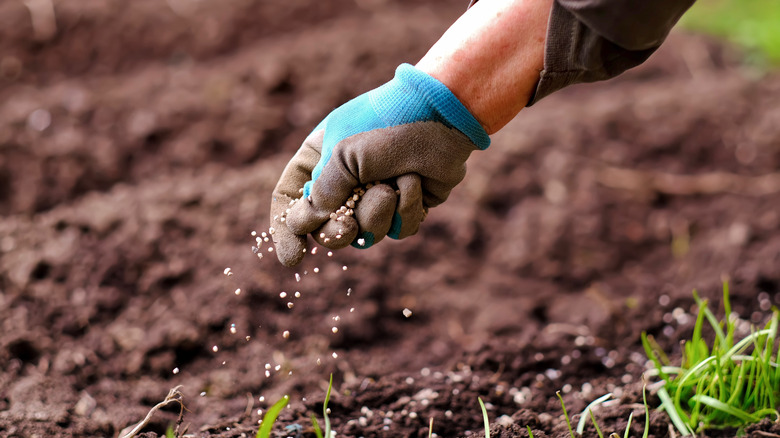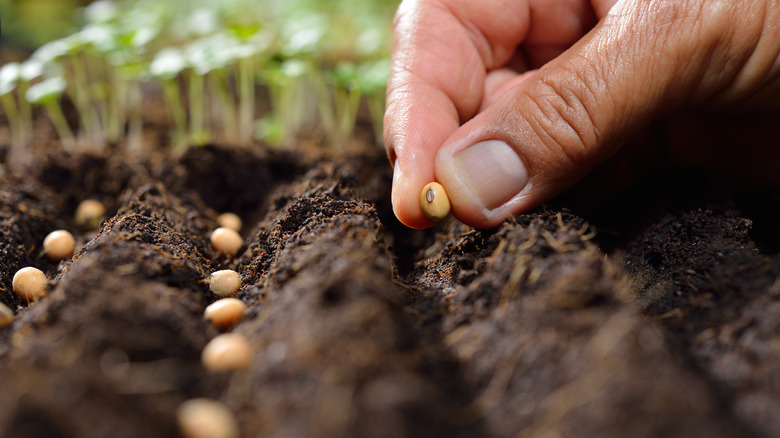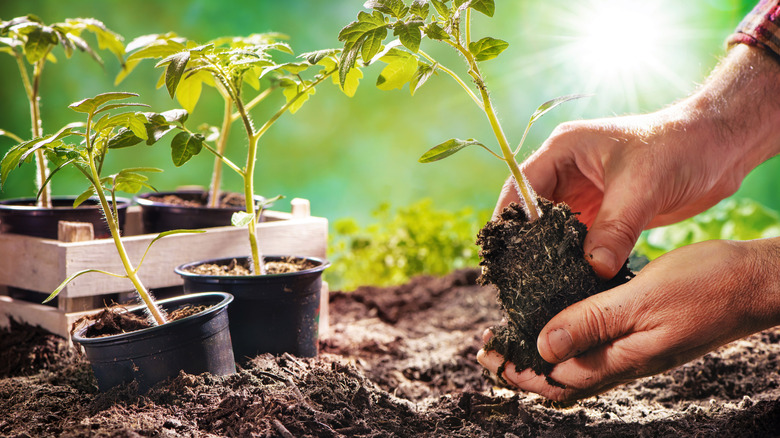How And When To Direct Sow Seeds In Your Garden
Growing and eating vegetables from our home gardens is always such an accomplished feeling — one many people look forward to each year. Deciding how to germinate your crops is essential to their healthy growth and whether you will be able to incorporate them into your delicious summer recipes. Directly sowing your seeds is one method gardeners can take, which simply means placing seeds straight into the ground outside. You'll be giving your plants a permanent home from start to finish, skipping the transplanting process and all the other time-consuming work that comes with indoor starters. You'll always want to consult your seed packet for the best time of year — but generally, planting seeds should be done in the spring.
However, even with how straightforward it is to direct sow seeds, not all types of plants will thrive in these conditions. Vegetables like tomatoes, eggplants, and peppers won't usually do well if directly planted outdoors. Still, numerous herbs, flowers, and vegetables, such as carrots, potatoes, corn, radishes, melons, and zucchini, will produce the juiciest produce when starting their growth immediately outside.
How to direct sow seeds
When you direct sow seeds, you follow a less linear path than with indoor starters. Each type of seedling will vary; some plants can be started immediately at winter's end when the ground defrosts, while others prefer planting when warmer temperatures approach. Reading your seed packets and researching each vegetation type will help you understand the necessary timing and process. Additionally, figure out what Ph levels the loam needs for healthy growth, adding any compost or other adjustments needed and removing obstructions like rocks, debris, and hard clumps of dirt. In addition, some species may require you to soak or scarify their seeds before planting.
As you begin, bury your seeds approximately three times their width and keep the environment evenly damp to provide the best conditions for successful growth. You shouldn't allow the soil to dry out, but you don't want to drown your freshly-planted seeds either. Also, remember to be gentle in your watering since some plants will germinate near the surface and can be damaged by harsh spraying. Marking the location of your plants will help you identify them throughout the season and assist you in removing weeds and thinning them out. Since you will likely plant clusters of seeds together for a better chance at growth, you may need to thin them out so they're not competing for resources if more than one seed develops.
Indoor starters vs. direct sowing
When deciding whether or not to create indoor starters for your plants or directly sow them, there are additional things to contemplate than just the type of plant you're growing. Indoor starters require more time, dedication, and equipment — like disposable pots, potting soil, lights, and heat lamps. These necessities can quickly weigh on your wallet, thus making the direct sow method more affordable.
Nevertheless, germinating your plants indoors gives you more control over their growth and environment. You don't have to wait for the weather to reach a specific temperature if you have the right gadgets to care for vegetation indoors. Pests and weeds also won't be anything you'd have to worry about in the beginning stages.
Direct sowing, however, offers you the ability to eliminate the transplanting process. Not only is this extra labor, but it can be traumatizing and deadly for certain plants. Any root vegetables and rhizomes should always be directly sowed if possible, and many other plants will benefit from not going through replanting. Typically, seeds planted immediately outside also have a higher resistance to dry climates. It is ultimately up to you to determine which gardening method is suitable for the produce you want to nurture, and performing both is never out of the question.


